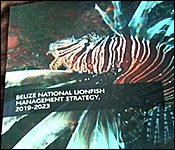Lionfish, the Long View

 For 10 years, since the invasive Lionfish species appeared in Belizean waters, we've been reporting on the threats and opportunities this presents.
For 10 years, since the invasive Lionfish species appeared in Belizean waters, we've been reporting on the threats and opportunities this presents.
The threat is that they feed off local reef fish which can harm the reef ecosystem, so Belize needs to reduce the population of lionfish. And that's where the opportunity comes in: Belizeans have to find wayy to consume and create using the colorful and quite tasty fish.
And that's why a national lionfish management strategy was launched today at the Coastal Zone Management Training room. Courtney Weatherburne has more on the importance of this plan.
Courtney Weatherburne reporting
Lionfish are visually mesmerizing creatures with their striped bodies and dotted fan-like fins. While these colorful fish may be appealing to look at, they aren't so pleasant to have around. They are an invasive species and are a major threat to the balance of the reef's ecosystem.
Jennifer Chapman, Blue Ventures, Belize Country Manager
 "The invasive lionfish was first was officially recorded in Belize in 2008 and since then the population has really exploded. We saw the peak of the population in 2011 and it dropped off again. The reason why we should be concerned about the invasive lionfish is that it is a predatory fish and feeds off juveniles and if you look on a reef which has a very high density of invasive lionfish you could expect to see very low populations of juvenile fish species and the repercussions of that are basically you can expect to see further down the line that fish populations on the reef are lower in diversity, lower in biomass and of course the knock on effect of that is fisheries productivity."
"The invasive lionfish was first was officially recorded in Belize in 2008 and since then the population has really exploded. We saw the peak of the population in 2011 and it dropped off again. The reason why we should be concerned about the invasive lionfish is that it is a predatory fish and feeds off juveniles and if you look on a reef which has a very high density of invasive lionfish you could expect to see very low populations of juvenile fish species and the repercussions of that are basically you can expect to see further down the line that fish populations on the reef are lower in diversity, lower in biomass and of course the knock on effect of that is fisheries productivity."
Beverly Wade, Fisheries Administrator
 "It has been proven that lionfish has the potential to reduce your biodiversity on your reefs and coastal ecosystems of up to 80 percent. That is concerning for any country like Belize where your coastal ecosystem is really central to a lot of your key economic activities."
"It has been proven that lionfish has the potential to reduce your biodiversity on your reefs and coastal ecosystems of up to 80 percent. That is concerning for any country like Belize where your coastal ecosystem is really central to a lot of your key economic activities."
Today a Marine Conservation Organization called Blue Ventures along with the Fisheries Department launched the first
National Lionfish Management Strategy. The strategy highlights what is being done to control the lionfish population in Belize and what additional measures can be implemented.
Jennifer Chapman, Blue Ventures, Belize Country Manager
"We have seen scuba divers, tour operators fishing associations and organizations and NGO's coming together with the fisheries department to address this issue and what we have been working on the last few years is trying to understand exactly where those efforts have been successful and also where they have been less successful and how we may be able to adapt the approach so what we did is we did these surveys with stakeholder communities and in the water and we tried to understand exactly what is going on in the system and from there we were able to develop the strategic plan and we are also going to be launching a working group which is tasked with implementing all the objectives and activities within the strategic plan."
Belize is considered a pioneer in lionfish management but there is still more work to be done to fully protect the reef.
Jennifer Chapman, Blue Ventures, Belize Country Manager
"About 78 percent of Belize's reefs currently have lionfish populations that are considered to be well managed so they are low enough that we don't think they will have a negative impact. Of course that means we have 22 percent where that is not the case and every piece of reef from north to south is important and relevant and valuable to somebody and to everybody so we want to try to expand the success from the 78 percent into that last remaining 22 percent."
"But we don't want to forget about the 78 percent, we want to keep the momentum, keep the energy going on that 78 percent so part of the work that this strategic plan says is let's not stop what we are doing we have seen that if you stop very quickly the lionfish population bounces back.:s
And you can count on that because lionfish are capable of reproduction in less than a year and they have no known predators so the lionfish management team needs all the reinforcement it can get to keep these uninvited guests from taking over.
Beverly Wade, Fisheries Administrator
"It is here to stay, there is no strategy for eradication so we have to have a strategy in place to effectively control it."
The strategy will be in effect from 2019 to 2023.
Channel 7

